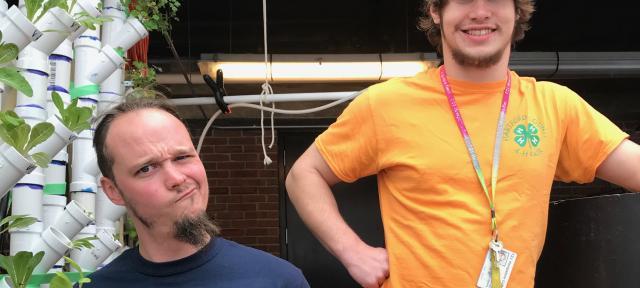Planning for Urban Farming

What’s the difference between hydroponics and aquaponics? “Fish,” students Robert Mueller and Liam Malone answer in unison. Both involve growing plants, a substrate such as gravel, and circulating water. But hydroponics utilizes additive nutrients, whereas aquaponics uses fish for the fertilizer, keeping the entire system self-sufficient.
Robert and Liam met in Sustainable Agriculture, a class taught by Brian Schultz, associate professor of entomology and ecology. Their final project evolved into a Div II for Robert and a Div III for Liam: an aquaponics closed-loop system made from PVC piping, rainwater gutters, giant tanks, and many powerful pumps.
It’s not actually a new idea; the ancient Chinese used aquaponics. The concept replicates a natural system like a bog. The twist in this case is the layout of the construction. Historically, most hydroponics and aquaponics used horizontal designs, which required growing outdoors or in areas with a large footprint. The vertical structure allows for more plants in a much smaller space and will work indoors.
Their aquaponics growing structure, which Robert and Liam refer to as a “wall,” is packed with a variety of edible greens, such as arugula, romaine lettuce, cilantro, basil, and chard. Salad ingredients sprout brightly from the openings of white, angled pipe pieces on one side of the wall and in the troughs of gutters on the opposite side. The setup is tall, but just a couple of feet wide.
To build their wall, the sustainably minded duo took advantage of free and inexpensive materials whenever they could. Some components were left over from a previous Div III project and others were found. The fish, which live close by in a giant water barrel, were caught by Robert in a lake near his Connecticut home.
“I like to make the best out of what you have,” Liam says, “scraps, funding sources, people who believe in the project. It’s fun to solve problems with what’s around.”
Several faculty and staff members have supported the students. The Entrepreneurship program led to their award of a Tim Harkness Fund for Invention Grant, and the Center for Design helped with money and the design. They also received assistance from the Samuel Morris Sustainability Endowment Fund and an Experimental Program in Education and Community grant.
Liam and Robert’s wall is housed in the Cole Science Center greenhouse, but embedded in their concept is that these designs will be scalable to any space, with or without natural light. Though Robert may continue to care for the current fixture, Liam has commercial aspirations. After graduation, this spring, he wants to start a local business to produce sustainable, healthy greens indoors — and maybe fish, too — all year long, something New Englanders would surely welcome during the long winters.
But first the team has to unravel some of the snags they’ve encountered along the way: Water quality, a case of aphids, and a pump fail are among the many challenges they’ve faced. They’ve lost some plants and fish as they’ve learned how to manage the complex integrated system they created.
“At Hampshire, it’s possible to do these independent studies, to learn and experiment without financial risk,” Robert says.
The good news? They just had funding approved to build a second wall.



